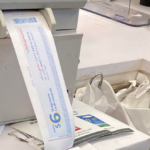
According to one study, the average number of products in a typical supermarket is 35,372. How many of those products do you purchase each year? How many do you think the average shopper buys? Think about all the items in your pantry, in your fridge, your freezer – and how many items you add to your stash over the course of an entire year. Why, you must buy thousands of different products, right?
Actually, out of 35,372 products stocked on stores’ shelves, the average shopper buys just 260 different items. In an entire year. Hope someone else is buying the rest of the 35,112 products that you don’t want, otherwise a whole lot of shelf space is going to waste.
That figure is one of the highlights of a study from Catalina Marketing, that looks at what it calls the “selective shopper”. “At a time of unparalleled choice in the grocery store, shoppers ignore all but a tiny fraction of available products,” said Todd Morris, Catalina’s Executive Vice President of corporate development and marketing.
Catalina examined purchases made by more than 32 million shoppers in nearly 10,000 grocery stores, during a one-year period. The average 260-item annual total represents just 0.7% of all products available. The dairy section had the highest ratio of purchases-made-to-products-available, though that was just 1.7%. The health and beauty care department had the lowest, at just 0.2%. Which means most of us ignore fully 99.8% of the health and beauty products available in our local grocery store.
But someone’s got to be buying the rest of all that stuff. You may be buying just 0.7% of all available products, but someone else is likely buying a different 0.7%. Much like snowflakes or fingerprints, the 32 million shoppers that Catalina studied were unique in their purchasing choices – no two shoppers ever purchased exactly the same items.
So while the percentages may seem alarming, they’re really just a reflection of just how many choices we have nowadays. Consider Tide, Catalina points out. “When Tide launched in 1949, it was a single product,” the report reads. “Today, Tide is a master brand encompassing some 43 highly differentiated laundry product brands” including a multitude of different scents, Pods, stain removers, etc.
And stores that don’t carry the full product line, do so at their peril. “Consumers want what they want, and they may go elsewhere if their current store doesn’t supply it,” Catalina’s report reads. “Brands need a broad assortment of offerings to address the meticulous desires of today’s consumers, but they also need more granular and personalized engagement to capture attention and retain loyalty in a cluttered and fragmented marketplace.”
In other words, Catalina is saying it’s time for the end of one-size-fits-all marketing, in favor of more personalized offers. How many times have you browsed your store’s weekly ad looking for deals, only to think, “meh, looks like a slow week for me”?
Turns out you’re not alone. Consider this startling statistic – Catalina honed in on one major grocery retailer’s weekly circular during the busy Memorial Day grocery shopping period last year, and found that of the 1,172 individual products on sale that week, two-thirds of all shoppers bought not a single one. Another 17% bought just one. Just 3% of all shoppers were interested enough in the weekly circular, to buy 5 or more advertised items. The following, non-holiday, week was even worse – 74% of shoppers didn’t buy a single advertised item, and 15% bought just one.
Traditional weekly circulars “may attract some shoppers who are highly attuned to getting the best deals and savings,” Catalina concludes, but “they fail to reach the vast majority of buyers. There must be more relevant and effective ways to reach consumers around the products and brands that matter to them.”
Of course, it just so happens that Catalina offers retailers and brands the ability to serve up personalized promotions based on past and present purchases. So its report is as much an advertisement for its services as it is a scholarly study. But it does highlight the challenges that marketers face in dealing with an increasingly segmented consumer base. And it calls into question the value and future of offering traditional one-size-fits-all coupons and sales.
So if you are one who still faithfully clips coupons and pores over the weekly grocery ads, be warned that the future – according to some – could look a whole lot different. Whether that future is better for consumers, or better for marketers, remains to be seen.











But how many items does the average shopper buy on a single trip to the store? Are they literally purchasing 206 items per year or is this the average of product variety? for example they buy 2000 items per year but they only choose between 206 specific items everytime they shop.
I’m asking because I’m curious as to how speedy the speedy checkout 20 items or less lane really is. Does the average shopper even purchase more than 20 items on a given trip to the grocery store? Am I choosing the speedy checkout lane in vain with my 5 items when 10 people are in front of me with 20 items and the average lane also has 10 people with 20 items or less? Lol. Just curious as to the actual efficiency of speedy checkouts.
260 sorry
Pingback: Brands Beware: More is Not More - Innovation Protocol
Pingback: Brands Beware: More is Not More - Innovation Protocol
UMMM it’s pours, not pores in the last paragraph.
Actually, no, it is “pore over” (“to read or study with steady attention or application”), unless you’re planning on literally “pouring” something over your grocery ad.